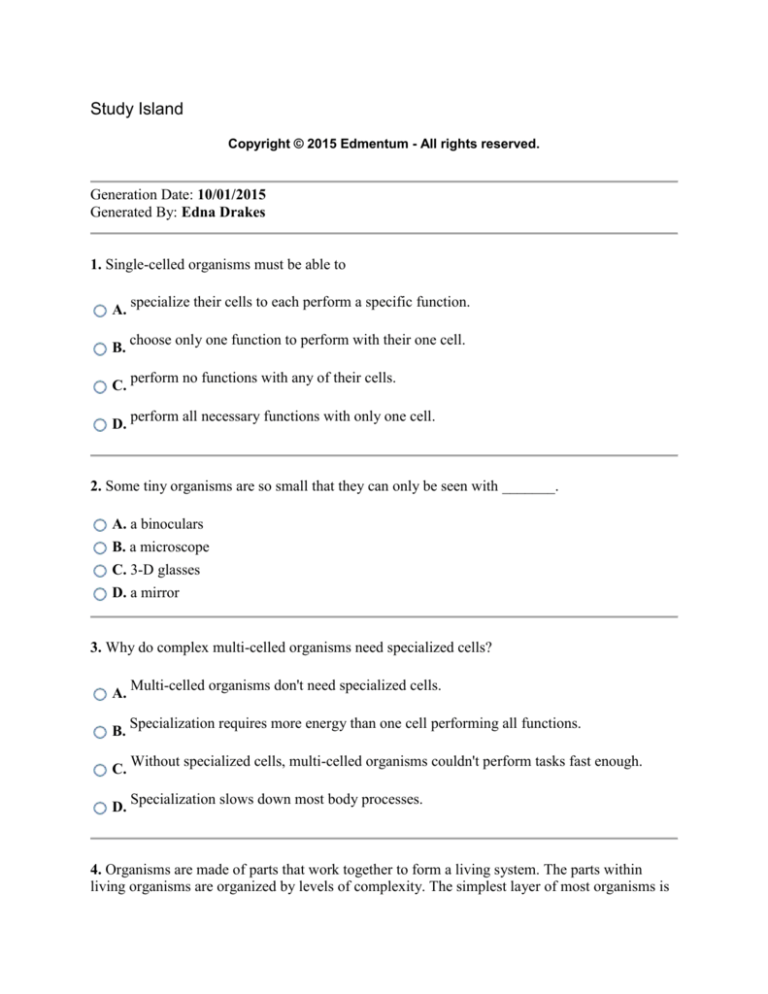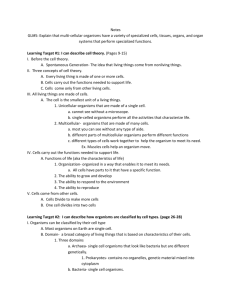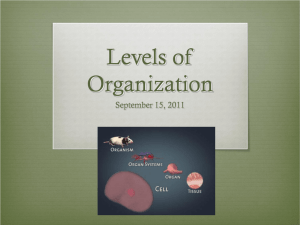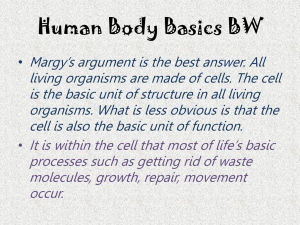
Study Island
Copyright © 2015 Edmentum - All rights reserved.
Generation Date: 10/01/2015
Generated By: Edna Drakes
1. Single-celled organisms must be able to
A.
B.
C.
D.
specialize their cells to each perform a specific function.
choose only one function to perform with their one cell.
perform no functions with any of their cells.
perform all necessary functions with only one cell.
2. Some tiny organisms are so small that they can only be seen with _______.
A. a binoculars
B. a microscope
C. 3-D glasses
D. a mirror
3. Why do complex multi-celled organisms need specialized cells?
A.
B.
C.
D.
Multi-celled organisms don't need specialized cells.
Specialization requires more energy than one cell performing all functions.
Without specialized cells, multi-celled organisms couldn't perform tasks fast enough.
Specialization slows down most body processes.
4. Organisms are made of parts that work together to form a living system. The parts within
living organisms are organized by levels of complexity. The simplest layer of most organisms is
the cell.
Which of the following describes the rest of the levels in order of complexity?
A. tissues → organs → organ systems → organism
B. organs → tissues → organ systems → organism
C. organ system → organism → organ → tissues
D. organism → organ systems → organs → tissues
5. The most complex organisms contain _________.
A. tissues but no organs
B. cells but no tissues
C. organs but no tissues
D. organs and organ systems
6. The pictures of the human cells below were taken by a camera attached to a microscope.
Human Muscle Cells
Human Blood Cells
These pictures show that different types of cells in the same organism
A. might look very different.
B. all perform the same role.
C. all have the same shape.
D. do not cooperate together.
7. The image below is a colony of algae cells.
Which of the following statements best describes colonies of algae?
Algae colonies are made of similar cells that work together.
A.
B.
C.
D.
Algae colonies contain many organs that perform different jobs.
Algae colonies are made of many types of cells that have different jobs.
Algae colonies are complex organisms with billions of cells.
8. Which of the following statements best describes the corn plants below?
Corn plants are made of millions of the same type of cell, but each cell performs a
A. different job.
B.
C.
D.
Corn plants are made of one large cell that can perform all of the needed jobs to survive.
Corn plants contain many types of cells that form tissues and organs with different jobs.
Corn plants are made of a few similar cells that all perform the same job for the plant.
9. Which of these things is made of cells?
A. rocks
B. water
C. plants
D. all of these
10. _______ are the smallest units of life.
A. Bugs
B. Cells
C. Bones
D. Eggs
Answers
1. D
2. B
3. C
4. A
5. D
6. A
7. A
8. C
9. C
10. B
Explanations
1. Single-celled organisms must be able to perform all necessary functions with only one cell.
Multi-celled organisms, however, can specialize each of their cells to perform different
functions.
2. A microscope is a tool that can help make very small things look bigger. Some cells and tiny
organisms are so small that they can only be seen using a microscope.
3. Many tasks must be performed in order for multi-celled organisms to stay healthy. To
accomplish these tasks, complex multi-celled organisms have developed specialized cells.
Specialized cells are able to accomplish many tasks using the least amount of energy and the
shortest amount of time. Without these specialized cells, multi-celled organisms would not be
able to meet the needs of their bodies fast enough.
4. The levels of complexity of living organism, from simplest to most complex are:
cells → tissues → organs → organ systems → organism
5. Organisms have different levels of organization. From simplest to most complex, the levels
are:
cells → tissues → organs → organ systems → organism
The most complex organisms have organs and organ systems.
6. In multicellular organisms, there are many different types of cells. These cells are specialized
to perform different roles within the body. Because they have different jobs, different cell types
may also look very different.
The different types of cells all benefit from cooperating so that they can keep the organism alive.
Image of blood cells courtesy of Armed Forces Institute of Pathology.
7. The cells in algae colonies are very similar to each other and work together.
Algae are simple organisms that are made of one or more cells. Some algae, like the type in this
question, live in colonies. Algae colonies are different from complex multi-celled organisms,
such as plants. Colonies usually do not have specialized tissues or organs.
8. Corn is a complex plant that has many types of cells that form tissues and organs with
different jobs.
Each plant is made of billions of cells. Similar cells make up tissues, and similar tissues make up
organs like leaves, stems, and roots.
9. Cells are the smallest unit of life. All living things are made up of cells.
Plants are alive, so they are made out of cells. Rocks and water have never been alive, so they
are not made of cells.
10. Cells are the smallest unit of life. All living things are made up of cells. Some living things
are made of only one cell.










